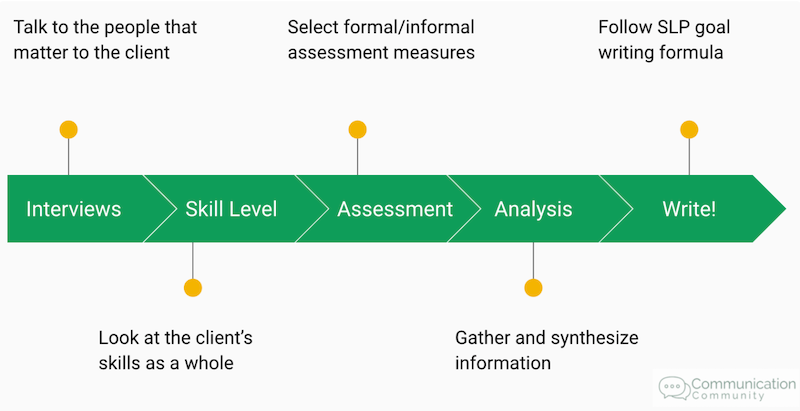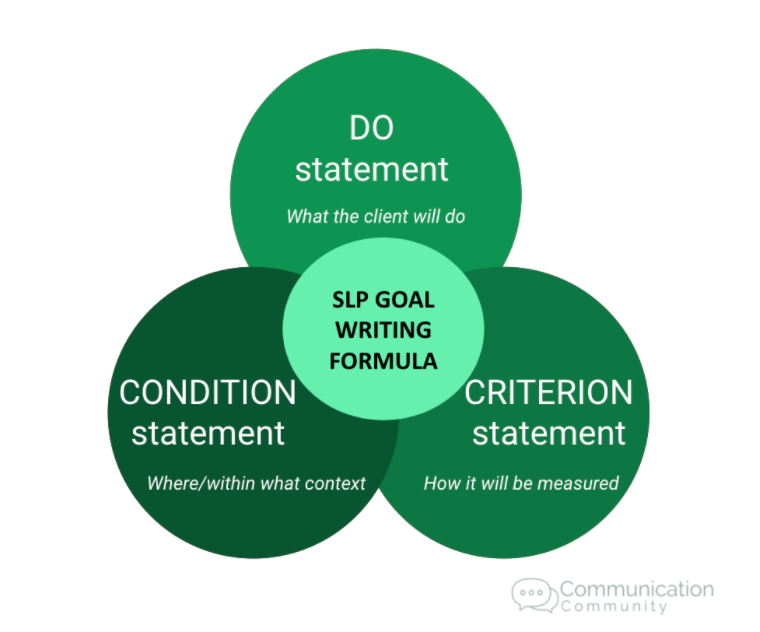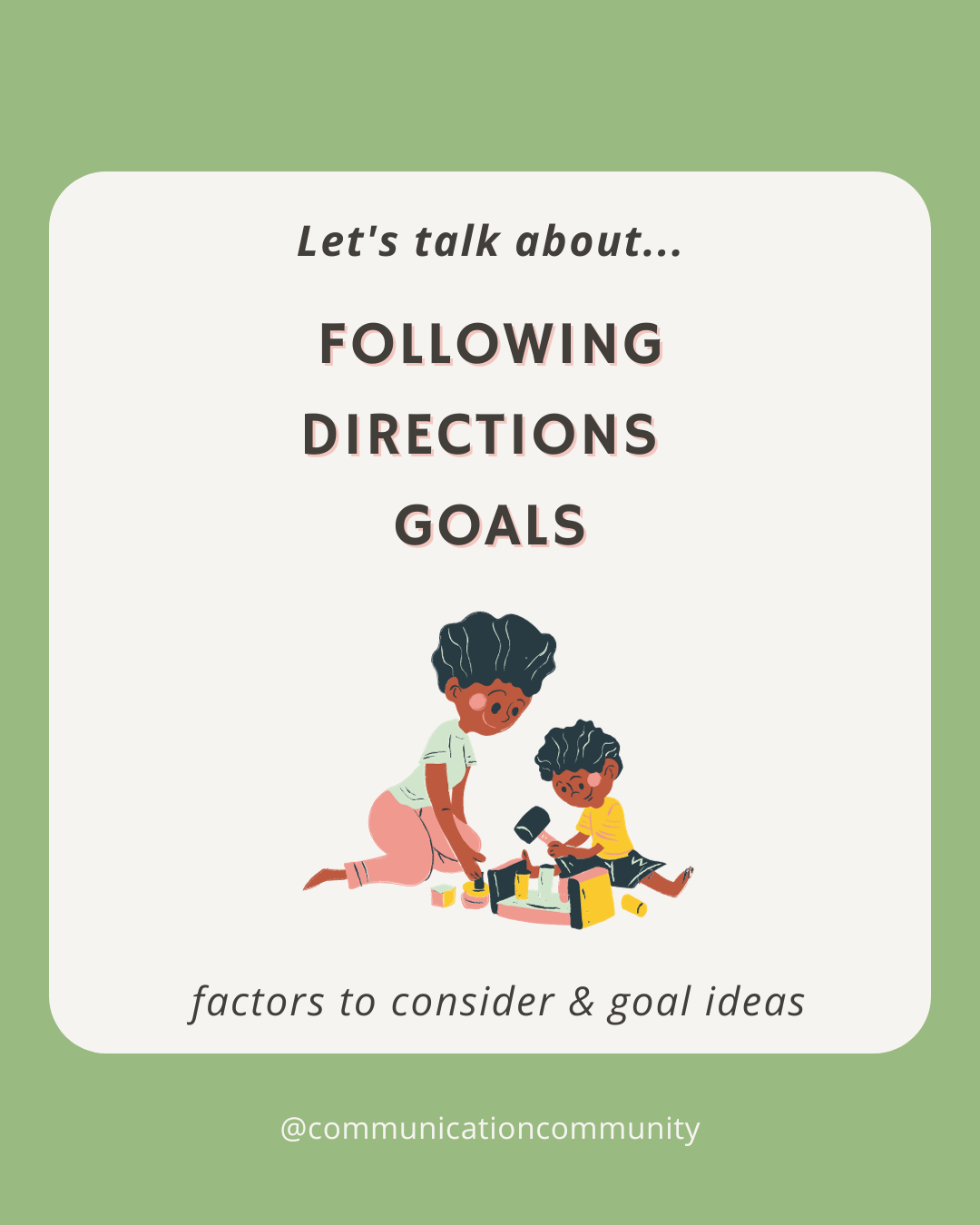Our comprehensive goal banks for school-aged language, AAC, Early Intervention & preschool, and fluency are available on our site or Teachers Pay Teachers store!
Save time creating goals with over THOUSANDS of possible goal combinations. Select your own combination of DO + CONDITION + CRITERION (and consistency) statements to develop personalized and measurable goals for your caseload.

Phonological Awareness
Phonological awareness is the ability to detect and manipulate sounds and syllables in words. It is critical for the foundation of a child's literacy development (aka - learning how to read and write). It is one of the milestones required for emergent literacy skills, in addition to print concepts (e.g., understanding which way to hold a book or the correct direction to read text), alphabet knowledge (i.e., understanding of letter names and their shapes), and literate language (i.e., understanding how to compose language elements for adequate communication).
Basically, phonological awareness is the awareness that words can be broken down into smaller units, such as syllables, onset-rime units, and phonemes.
For more information about these units, check out our recent article, What is Phonological Awareness?
Phonological Awareness Skills
There are various skills that can be targeted in speech and language therapy to improve phonological awareness. Speech-language pathologists help individuals develop skills within the five domains of language, including phonology. Phonological awareness is part of understanding and using phonemes correctly. These skills are initially taught within the general education curriculum and increase in complexity with each subsequent grade level. It is important that a child achieves foundational phonological awareness skills so that they are on the trajectory to be literate and academically successful as they get older. Encouraging and providing exposure to these forms of phonological awareness skills (at school/home, in therapy, etc.) are important for increasing literacy development. Individuals may need targeted intervention to develop these skills if they do not master them when exposed to the general education curriculum. According to Roseberry-McKibbin & Hegde (2016), skills include:
Rhyming: identification of words that sound alike (car - star)
Syllable awareness: knowledge of how many syllables are in a word
Phoneme isolation: identifying whether the sound is at the start, middle, or end of a word
Sound blending: blending two or more sounds together, temporarily separated by a few seconds (e.g., “c - a - t --- what animal is that?”)
Writing Phonological Awareness Goals
If you haven’t already, check out our recent article that outlines How to Write Speech Therapy Goals. For the purpose of this article, we will focus specifically on writing goals for increasing phonological awareness skills during therapy.


As seen above, speech goals should be written with 3* components in mind: the DO statement, the CONDITION statement, and the CRITERION statement.
*Also commonly included is consistency (we incorporate this!). Aka: does the individual have to meet a specific criterion more than once? A common example of this may include across 3 consecutive sessions. This is usually something understood by the therapy organization/service provider and is sometimes/sometimes not included in the written goal itself. Including consistency statements ensure that the skill has been generalized and provides more reliable data that the skill has been properly mastered.
DO statement
What the client is actually going to DO and the specific skill they will be working towards.
Example: will identify each syllable within multi-syllabic words
CONDITION statement
The specific setting and/or context your client will work on this skill.
Example: during structured drill tasks
CRITERION statement
How the client’s performance will be measured.
Example: with 80% accuracy
DO + CONDITION + CRITERION
Example: [Client] will identify each syllable within multi-syllabic words, during structured drill tasks, with 80% accuracy
There you have it! An example using our Goal Writing Formula containing the DO + CONDITION + CRITERION (don’t forget to think about consistency!) for increasing phonological awareness skill areas.
Phonological Awareness Goal Bank
Rhyming
Example #1: [Client] will circle the two words that rhyme, when presented in a field of 4-5 words, with 90% accuracy.
Example #2: [Client] will state a word that rhymes with a given word, during a structured reading exercise, in 4 out of 5 opportunities.
Syllable Awareness
Example #1: [Client] will underline the first syllable within a given word, when presented in a worksheet format, with 80% accuracy.
Example #2: [Client] will tap out each syllable within words, during a structured activity, in 9 out of 10 trials.
Phoneme Isolation
Example #1: [Client] will produce each phoneme within familiar 3-letter words, when presented on flashcards, with 70% accuracy.
Example #2: [Client] will identify the words that begin with the same sound as a given word, when presented with visual stimuli (i.e., pictures/items), in 8 out of 10 trials.
Sound Blending
Example #1: [Client] will state the correct word when provided with a sound blend (e.g., “c - a - t --- what animal is that?”), during a structured activity, with 90% accuracy.
Example #2: [Client] will blend each individual phoneme to produce a complete word, during a reading task with the clinician, in 4 out of 5 opportunities.
Read more about phonological awareness and potential deficits to determine if these goals could be appropriate for your client!
Looking for more?
For more goals posts, check out our collection of other speech and language goals:
- How to Write Pragmatic Language Goals
- How to Write Receptive Language Goals
- How to Write AAC Goals
- How to Write Articulation Goals
- How to Write Expressive Language Goals
- How to Write Play Skills Goals
- How to Write Fluency Goals (Stuttering)
- How to Write Voice Goals (Pediatric)
- How to Write Cluttering Goals
Want to know how we prep ourselves for goal-writing (and more)?
These are some of our favorite resources for working:
- Blue light glasses - placebo effect or not, they make a huge difference for me!
- Lap desk - for when working on the couch is needed (or wanted)
- Notepads - does anyone else make lists on lists on lists? Or just me?
Citations/further resources
Roseberry-McKibbin, C., & Hegde, M. N. 1. (2016). An advanced review of speech-language pathology: Preparation for PRAXIS and comprehensive examination (4th ed.). Austin, Tex.: PRO-ED
https://www.communicationcommunity.com/what-is-phonological-awareness/

![How to Write Phonological Awareness Goals [with goal bank]](https://www.communicationcommunity.com/content/images/2022/06/Phonological-awareness-goals.png)
![How to Write Early Intervention Goals for Speech Therapy [goal bank included]](https://www.communicationcommunity.com/content/images/2024/05/How-to-Write-Early-Intervention-Goals---ghost-cover--1--1.png)
![How to Write Stuttering Goals [with goal bank]](https://www.communicationcommunity.com/content/images/2024/03/How-to-Write-Stuttering-Goals---ghost-cover--1-.png)
![How to Write AAC Goals [with goal bank]](https://www.communicationcommunity.com/content/images/2024/03/How-to-Write-AAC-Goals---ghost-cover.png)

![How to Write Apraxia Goals [with goal bank]](https://www.communicationcommunity.com/content/images/2024/01/Apraxia-Goals.png)
